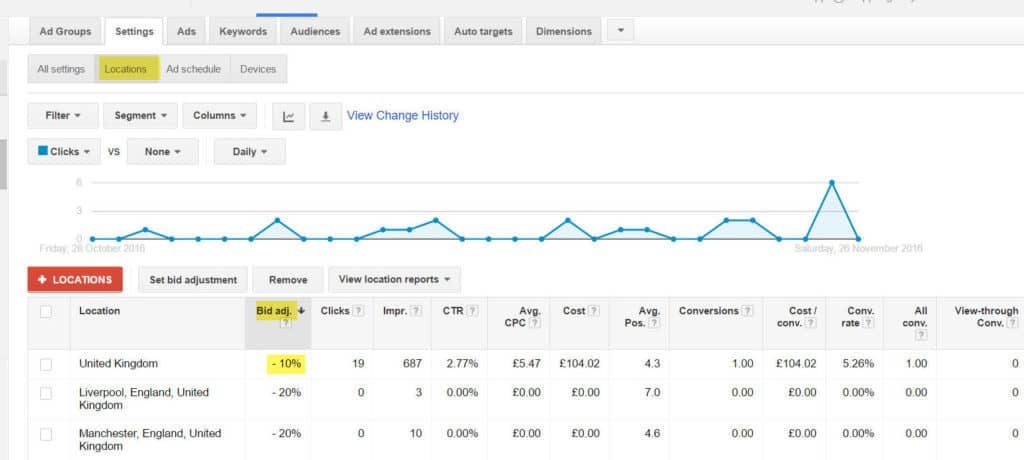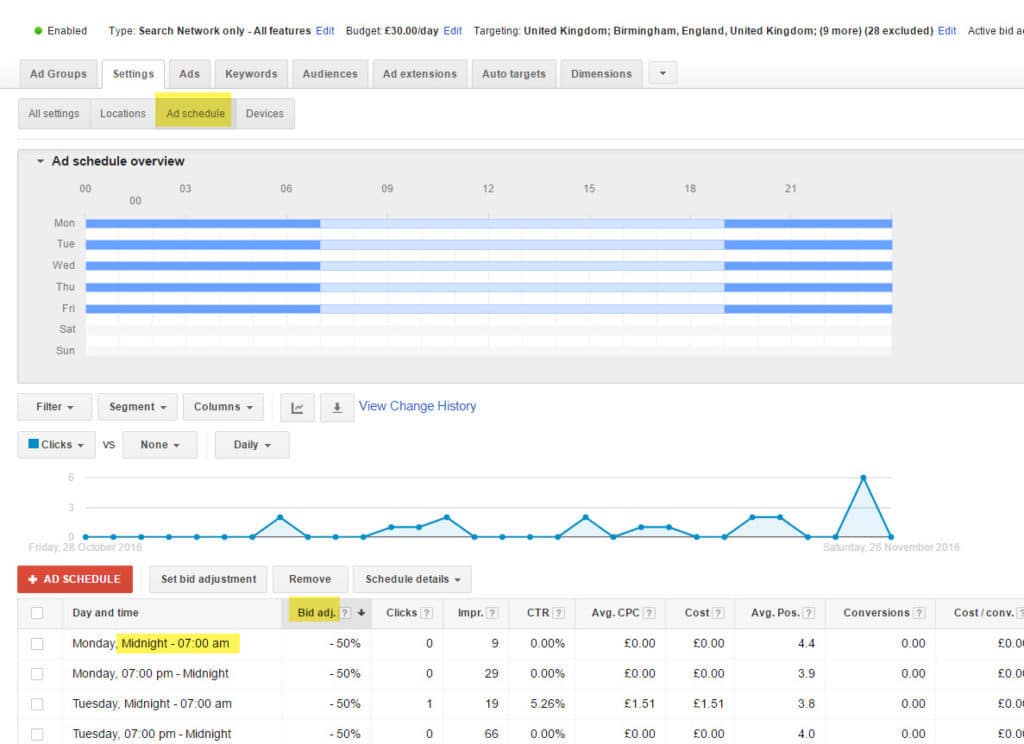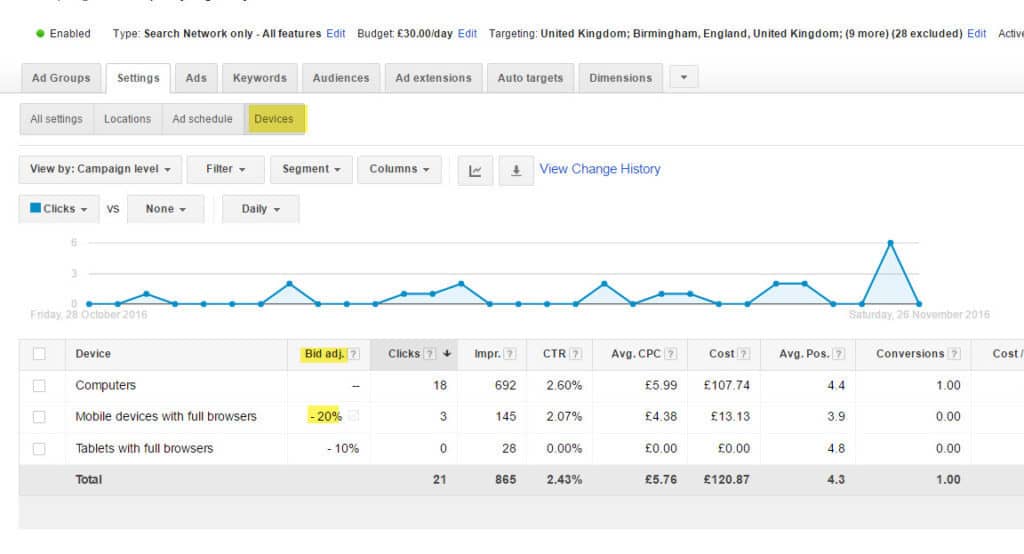As a user of Google Ads, you’re likely familiar with the process of bidding on keywords. However, there’s a way to further refine your bidding strategy and have greater control over your advertising spend while achieving a higher return on investment (ROI). This method is called “Bid Adjustments.”
After running Google Ads for some time, analysing performance metrics can reveal the best-performing keywords, locations, times, and devices. By adjusting your bids, you can optimise your ROI for these areas that yield better results. Google Ads stands out among online advertising platforms due to its bid adjustment capabilities. These adjustments enable advertisers to fine-tune their bids based on various factors, leading to improved campaign performance and maximised ROI.
By leveraging bid adjustments effectively, you can drive your advertising campaigns towards success and unlock the full potential of your online marketing initiatives. So lets explore bid adjustments, where we’ll share practical strategies and best practices.

What are Bid Adjustments?
In the world of Google Ads, bidding on keywords is a familiar concept. However, there’s a powerful technique that can take your bidding strategy to new heights: Bid Adjustments. With bid adjustments, you have the ability to make precise modifications to your bids, giving you greater control over your advertising spend and the potential for better outcomes. In this comprehensive guide, we’ll delve into the realm of bid adjustments within Google Ads, providing valuable insights on how you can leverage them to optimise your advertising efforts.
As you run your Google Ads campaigns over time, analysing performance metrics becomes essential. This analysis unveils valuable information about the best-performing keywords, locations, times, and devices. By adjusting your bids, you can optimise your return on investment (ROI) by prioritising these high-performing areas. What sets Google Ads apart is its robust bid adjustment capabilities, allowing you to fine-tune your bids based on various factors. This empowers you to improve your campaign performance and maximise your ROI.
In the forthcoming blog post, we’ll provide you with insightful strategies and best practices to effectively leverage bid adjustments. By mastering this powerful tool, you’ll be able to drive your advertising campaigns towards success and unlock the full potential of your online marketing initiatives. So stay tuned for an informative exploration of bid adjustments that will revolutionise your Google Ads experience.
Benefits of Bid Adjustments
Bid adjustments offer a range of benefits that can significantly enhance your advertising campaigns in Google Ads. Here are some key advantages of using bid adjustments:
Targeting Precision:
Bid adjustments allow you to target your ads with laser-like precision. By adjusting your bids for specific criteria such as device type, location, time of day, and more, you can ensure your ads reach the right audience at the right time and place. This level of targeting precision maximises the relevance of your ads and increases the likelihood of driving conversions.
Improved Return on Investment (ROI):
Bid adjustments enable you to optimise your advertising spend and achieve a higher return on investment (ROI). By allocating more budget to areas that generate better results and reducing bids for less effective areas, you can ensure your resources are focused on the most profitable segments of your audience. This targeted approach helps you make the most out of your ad budget and drive better business outcomes.
Flexibility and Experimentation:
Bid adjustments provide flexibility and room for experimentation in your campaigns. You can easily test different strategies and ideas by applying bid adjustments to specific targeting criteria. This allows you to explore new opportunities, gather valuable insights, and refine your advertising approach without the need for extensive resources or time-consuming setup.
Competitive Advantage:
With bid adjustments, you can stay ahead of the competition by adapting to changing market conditions. By monitoring performance metrics and adjusting bids accordingly, you can respond quickly to trends and outperform competitors who may not be leveraging bid adjustments effectively. This proactive approach keeps your campaigns agile and positions you for success in a dynamic advertising landscape.
Campaign Optimisation:
Bid adjustments empower you to optimise your campaigns for maximum performance. By analysing performance metrics and adjusting bids based on the best-performing keywords, locations, times, and devices, you can fine-tune your campaigns to deliver superior results. This continuous optimisation helps you improve click-through rates, conversion rates, and overall campaign effectiveness.
In summary, bid adjustments provide precise targeting, improved ROI, flexibility for experimentation, a competitive edge, and campaign optimisation. By leveraging bid adjustments effectively, you can unlock the full potential of your advertising campaigns and achieve outstanding results in Google Ads.
How Do Bid Adjustments Work?
Let’s take a closer look at how bid adjustments work. Within Google Ads, there are base bids and modifier bids. The modifier bids enable further refinement of your bidding at different levels, such as device, location, time of day, top content, targeting method, remarketing lists, and phone interactions. Through bid adjustments, you can raise or lower your bids in specific scenarios, strategically increasing the visibility of your ads.
Consider this example: Suppose you run a florist business and utilise Google Ads throughout the year. However, during certain periods when demand for your business is higher, like Valentine’s Day, you may want to adjust your bids to target more aggressively. Bid adjustments allow you to allocate a higher bidding amount during these crucial periods, ensuring maximum exposure for your business. Once the Valentine’s Day rush subsides, you can return your bids to their normal levels.
It’s important to note that bid adjustments modify the original bid, which is an average of various factors, before any adjustments are made. While manual bidding, automated bidding rules, or script bidding are still options, automatic bidding by Google cannot be combined with bid adjustments. As a result, individual click costs may vary as your bids increase or decrease based on the adjustments you set.
In essence, bid adjustments involve modifying your set bids by a percentage, taking into account factors such as location, device, time of day, past website visitors, and more. These adjustments fine-tune your bids to increase or decrease them based on the relative performance of each factor, ultimately improving your ROI. The bid modifier adjustments are determined by evaluating performance across devices, locations, time of day, and other relevant factors. Typically, conversion metrics such as cost per lead or sale play a significant role in determining the performance of your bids.
Types of Bid Adjustments
Google allows you to adjust ads based on:
- Device
- Location
- Ad schedule
- Demographics
- Top content (Display)
- Targeting methods
- Remarketing lists for search ads (RLSA)
- Interactions, such as calls
Device bid adjustment
Tailoring your bids for mobile, tablets, and desktop devices based on their relative performance can be a game-changer for your advertising campaigns. By adjusting bids, you can allocate your resources more strategically, bidding lower for devices that are less profitable and higher for the best-performing ones. This targeted approach allows you to maximise your return on investment (ROI) and drive better results.
To make informed bid adjustments, you can consider using a target metric like Cost Per Acquisition (CPA). By analysing the performance data, you can identify which devices yield a lower CPA and adjust your bids accordingly. Lowering bids for less profitable devices ensures that you optimise your spending and focus your budget where it generates the best results.
Furthermore, you have the option to adjust bids based on the percentage variation in performance, even without increasing bids on the best-performing keywords. This approach allows you to maintain a standard bidding strategy while still reducing bids for underperforming devices. By carefully analysing the performance metrics and making appropriate bid adjustments, you can strike a balance between efficiency and profitability.
Remember, bid adjustments offer flexibility and allow you to experiment with different strategies. You can explore various combinations of bid adjustments and standard bidding to find the optimal approach for your campaigns. By continuously monitoring performance metrics and refining your bid adjustments, you can drive better outcomes and maximise the impact of your advertising efforts.
So, don’t miss out on the potential to optimise your device-specific bids. Harness the power of bid adjustments to fine-tune your advertising performance, increase profitability, and take your campaigns to new heights.
Location bid adjustments
Unlock the power of location-based bid adjustments and take your advertising campaigns to the next level. With this advanced feature, you can strategically increase or decrease your bids based on the performance of each specific location. Whether it’s towns, postcodes, cities, IP radius, or even entire countries, you have the flexibility to fine-tune your bids and maximise your advertising impact.
By analysing the performance data, you can identify which locations are delivering exceptional results and deserve a boost in bids. These high-performing areas hold the key to unlocking untapped potential and attracting your target audience. By increasing your bids for these locations, you ensure that your ads appear more prominently, increasing visibility and capturing the attention of potential customers.
Conversely, you may find that certain locations are underperforming or less relevant to your target audience. In such cases, reducing your bids for these areas can help optimise your budget allocation. By bidding lower for these locations, you can ensure that your resources are focused on areas that generate the best return on investment (ROI), thus maximising your advertising efficiency.
Keep in mind that location-based bid adjustments provide you with granular control over your advertising strategy. You can target specific geographic areas where your products or services resonate the most, ensuring that your message reaches the right people at the right time and place.
Don’t limit yourself to generic targeting. Leverage the power of location-based bid adjustments to tailor your bids for each location’s unique performance. Embrace this level of precision and unlock the full potential of your advertising campaigns. With the right adjustments, you can achieve greater reach, and engagement, and ultimately, drive better business results. So, dive into the data, discover the hidden gems in your location performance, and let bid adjustments guide your way to advertising success.

Ad scheduling bid adjustments
Unleash the power of ad scheduling and take your bidding strategy to new heights. With ad scheduling, you have the ability to increase or decrease your bids for specific hours of the day and days of the week, giving you unparalleled control over your advertising performance.
By analysing performance data, you can uncover the golden hours and days when your target audience is most active and engaged. These insights allow you to strategically increase your bids during peak periods, ensuring maximum visibility and engagement with your ads. This targeted approach puts your brand in front of the right audience at the most opportune moments, leading to higher click-through rates and conversions.
Conversely, you can decrease your bids during less active periods, optimising your budget allocation and ensuring that you’re not wasting resources when audience engagement is lower. This level of flexibility allows you to fine-tune your bids and make the most out of every advertising opportunity.
Ad scheduling empowers you to align your advertising strategy with the behavioural patterns of your target audience. Whether it’s adjusting bids for specific hours during weekdays, weekends, or even seasonal fluctuations, you can tailor your approach to match their preferences and maximise your return on investment (ROI).
Don’t settle for generic bidding strategies. Embrace ad scheduling and seize control over when and how your ads are displayed. By strategically adjusting your bids for specific hours of the day and days of the week, you can ensure that your advertising efforts are optimised for success. So, dive into your performance data, identify the peak moments, and let ad scheduling supercharge your campaigns. Get ready to unlock new levels of effectiveness, engagement, and ultimately, drive exceptional business results.

Display Network Targeting methods bid adjustments
Elevate your Display Network advertising game with the power of bid adjustments for targeting methods. With bid adjustments, you can finely tune your bids for topics, placements, and other targeting methods on the Display Network, all at the individual ad group level. This level of control allows you to optimise your bidding strategy and maximise the effectiveness of your campaigns.
By setting bid adjustments for topics, you can prioritise certain topics that align closely with your products or services. Increase your bids for topics that are highly relevant to your target audience, ensuring that your ads have a greater chance of being displayed on websites and content related to those topics. This targeted approach enhances the visibility of your ads among interested users, increasing the likelihood of driving engagement and conversions.
In addition, bid adjustments for placements enable you to adjust your bids based on the performance of specific websites or placements on the Display Network. Identify high-performing placements that consistently deliver valuable traffic and conversions and increase your bids accordingly to secure more prominent ad placements on those sites. This strategy allows you to capture the attention of your target audience within a context that resonates with them, ultimately driving better campaign results.
Moreover, bid adjustments for other targeting methods offer even more flexibility. Whether it’s adjusting bids for audience segments, demographics, or even remarketing lists, you have the power to fine-tune your bids to precisely reach your intended audience. This level of granularity ensures that your ad spend is focused on the most promising opportunities, maximising your return on investment (ROI).
Don’t settle for generic targeting on the Display Network. Leverage bid adjustments for targeting methods and take full control of your bidding strategy. By setting adjustments at the individual ad group level, you can tailor your bids to the specific needs and performance of each campaign. So, dive into your targeting data, identify the winning topics, placements, and targeting methods, and let bid adjustments propel your Display Network campaigns to new heights of success.
Remarketing lists for search ads bid adjustments
It is possible to set bid adjustments for past website visitors as they search on Google. This audience can be segmented based on their levels of engagement or pages viewed. For example, you can increase bids by 25% for past website visitors in the last 30 days or increase bids by 40% for site visitors who stayed on the website for longer than 5 minutes.
Implementing bid adjustments for past website visitors in Google Ads can revolutionise your advertising strategy. By segmenting visitors based on their engagement levels or specific pages viewed, you can customise your bidding strategy to target these valuable audiences more effectively.
To get started with bid adjustments for past website visitors, follow these steps:
1. Access your Google Ads account and navigate to the campaign you want to modify.
2. Go to the “Audiences” tab within the campaign.
3. Click on “Website Visitors” or “Remarketing” to set up your bid adjustments for past website visitors.
4. Create custom segments based on levels of engagement or specific pages viewed.
5. For each segment, determine the bid adjustment percentage based on its value. For example, you might increase bids by 25% for visitors in the last 30 days or by 40% for visitors who spent more than 5 minutes on your website.
6. Apply the bid adjustments to each segment accordingly.
7. Save your changes.
By setting bid adjustments for past website visitors, you can allocate a higher bid to audiences that have already shown interest in your website. This strategy increases the chances of capturing their attention and driving conversions.
Regularly monitor the performance of your bid adjustments for past website visitors and make refinements as necessary. Analyse the data to understand which segments are delivering the best results and adjust bids accordingly to maximise your campaign’s performance.
Remember, bid adjustments for past website visitors allow you to target a qualified audience with a higher probability of conversion. By leveraging this feature in Google Ads, you can optimise your advertising strategy, improve engagement, and boost your return on investment. Don’t miss out on the opportunity to connect with your valuable website visitors and maximise the effectiveness of your campaigns.
Demographic Bid Adjustments
Demographic bid adjustments in Google Ads allow advertisers to modify their bids based on specific demographic criteria such as age, gender, and household income. This targeting method helps advertisers tailor their bids to specific segments of their target audience, ensuring that their ads reach the most relevant individuals.
To implement demographic bid adjustments in Google Ads, you can follow these steps:
1. Access your Google Ads account and navigate to the campaign you want to modify.
2. Go to the “Audiences” tab within the campaign.
3. Click on “Demographics” to select the demographic targeting method.
4. You will see columns such as “Gender” and “Age” displaying the performance metrics for each demographic group.
5. To make bid adjustments, click on the bid amount in the “Bid adj.” column for the desired demographic audience.
6. Adjust the bid percentage up or down to increase or decrease the bid for that particular demographic segment.
7. Save your changes.
By adjusting bids for specific demographic groups, you can allocate more budget towards audiences that are more likely to convert and yield better results. For example, if you find that your product or service is more popular among a certain age group or gender, you can increase your bids for that demographic to increase visibility and reach within that segment.
It’s important to regularly monitor the performance of your demographic bid adjustments and make refinements as necessary. Analyse the data to identify which demographic groups are driving the most conversions and adjust bids accordingly to optimise campaign performance.
Demographic bid adjustments provide advertisers with a valuable tool to fine-tune their bidding strategy and target their advertising efforts towards specific segments of their audience. By leveraging this feature in Google Ads, you can enhance the relevance and effectiveness of your campaigns, ultimately driving better results and maximising your return on investment.
How significant can the adjustments be?
Very significant. Adjustments can be -90% of your bid, which is useful if you are, for example, seeking to reduce your bids based on opening hours at your business’ physical location. Alternatively, your bids can be adjusted by up to +900%, which is useful if you are looking to capture a surge in potential traffic – for example, if you sell last-minute Christmas gifts, increasing your bids significantly on December 23rd may be advantageous.
While bids can primarily only be decreased by -90%, there is one exception: you can use -100% if you wish to filter out searches on a mobile device.
Can you make multiple adjustments to one bid?
Yes, you can apply multiple adjustments to a bid – including additions and subtractions to the same bid – in order to better target your customers. To demonstrate this, let’s say that you run a brick and mortar store in New York which is open Monday through to Saturday, but closes on Sunday:
- Your core bid is set at $1.00
- As you run a brick and mortar store, users who are based in New York are more valuable to you. To reflect this, you apply a +100% bid adjustment for users based in New York.
- Your total bid is now $2; $1.00 original bid, $2.00 for users based in New York.
- You now want to adjust bids that are conducted on Sundays, as your store is closed that day. You don’t want to totally erase Sunday searches, because there is always the chance that your customers will search on a Sunday with the intention of visiting during the week, but you do want to substantially reduce the cost of clicks performed on that day.
- As a result, you apply a -40% bid adjustment for Sunday searches.
- Your total cost for a search that occurs on a Sunday, by a user registered in New York, will now be $1.20.
Google has helped to simplify the process by providing a calculator. To access the calculator, select:
- All Campaigns
- Settings
- Under the “All settings” subtab, look to the “Active bid adjustments” column.
- You should be able to see a calculator icon which, when selected, opens the calculator and allows you to tailor your bids from there.
What are the Limitations of Bid Adjustments
When using automated bidding strategies like Max ROAS and Max CPA, there are limitations to the scope of bid adjustments you can make. While bid adjustments are generally available across most campaign options, these automated strategies restrict certain types of adjustments.
For example, with Max ROAS and Max CPA bidding, the only bid adjustment available is for mobile devices, allowing you to decrease bids by 100% to exclude them from targeting. However, you cannot adjust bids based on specific time of day or location.
In manual bid adjustment strategies, on the other hand, you have more flexibility and control. You can directly set and adjust bids for various targeting parameters like devices, locations, times of day, and demographics. This allows you to fine-tune your bidding strategy based on specific performance data and optimise campaigns accordingly.
Automatic bidding strategies, such as Google Ads’ Smart Bidding, use machine learning algorithms to optimise bids based on performance goals. While efficient, the specific bid adjustments made by the algorithm are not directly customisable by the advertiser.
To summarise, if you require more granular control over bid adjustments based on factors like time of day or location, manual bid adjustment strategies provide greater support and flexibility. However, if you prefer the efficiency of automated bidding, you’ll have limited control over specific bid adjustments.
It’s important to consult the official documentation and resources provided by the advertising platform or seek guidance from digital advertising specialists for the most up-to-date details and recommendations regarding bid adjustments in the context of your chosen strategy.
How can you get started using bid adjustments?
To get started using bid adjustments effectively, follow these steps:
1. Analyse past performance:
Review your previous CPC (Cost-Per-Click) performance data to identify patterns and areas of strength. Look for insights such as high-performing locations, times of day, devices, or audience segments. This analysis will help you identify potential areas where bid adjustments can be applied.
2. Identify areas of opportunity:
Based on your analysis, pinpoint the areas where bid adjustments could have a positive impact. For example, if certain locations consistently show better performance, consider increasing bids for users from those locations. Similarly, if there are specific times of day when your ads perform well, adjust bids to reflect office hours or peak times.
3. Implement bid adjustments:
Access the bid adjustment settings within your advertising platform and apply the adjustments based on your identified areas of opportunity. Increase or decrease bids by a certain percentage to align with your goals. Remember to start with conservative adjustments and monitor the impact before making significant changes.
4. Monitor and track results:
Regularly monitor the performance of your campaigns after implementing bid adjustments. Keep an eye on key metrics like click-through rates (CTR), conversion rates, and return on investment (ROI). Use the platform’s reporting tools or third-party analytics solutions to gain insights into the effectiveness of your bid adjustments.
5. Test and iterate:
Bid adjustments are not a one-time setup. Continuously test and iterate your bid adjustment criteria to find what works best for your campaigns. Experiment with different bid adjustment levels and combinations to optimise performance. Keep track of your findings and implement any successful discoveries into your ongoing bidding strategy.
6. Stay informed and adapt:
Stay updated with industry trends, platform updates, and changes in user behavior. Adjust your bid adjustments as needed to align with changing market conditions and user preferences. Regularly analyse performance data and make adjustments accordingly to maximise your CPC strategy’s effectiveness.
Remember that bid adjustments should be based on data and testing rather than assumptions. By continuously monitoring and refining your bid adjustments, you can improve your campaigns’ performance and achieve better results over time.
Note: The steps provided above are general guidelines. The exact process may vary depending on the advertising platform you’re using. Refer to the platform’s documentation and resources for specific instructions on setting up and managing bid adjustments.
Conclusion
Bid adjustments in Google Ads are a powerful tool that allows advertisers to optimise their campaigns and maximise ROI. By fine-tuning bids based on factors like devices, locations, times, and demographics, advertisers can reach the right audience at the right time.
Regular analysis of performance metrics is essential for successful bid adjustments. Testing different adjustments, measuring their impact, and refining the strategy based on results is key. Bid adjustments are an ongoing process that requires continuous monitoring and optimisation.
Google Ads offers a range of options for bid adjustments, including device, location, time, and demographic adjustments. Leveraging these features enables advertisers to target their audience more effectively and drive better results.
With bid adjustments, advertisers can optimise their budget, improve campaign performance, and increase conversions. Embracing bid adjustments in Google Ads unlocks the full potential of advertising campaigns.
Remember to stay proactive, adapt bid adjustments based on data-driven insights, and continuously monitor performance. By harnessing bid adjustments effectively, advertisers can propel their Google Ads campaigns to new heights and achieve impactful results.












2 thoughts on “Google Ads Bid Adjustments – How to Improve Base Bidding ROI”
I’m trying to combine these – for example – Is it possible to reduce bids on tablets on Sundays by 25%? Just learning about scripts, but apparently, you can do this just in the online interface?
Thanks!
Hi Drew,
You can use the bid modifier adjustments in AdWords for devices.
This script changes the base bids – then the adjustments can happen independently. We are working on a separate script that will do the bid adjustments automatically.
Best Regards
Liam